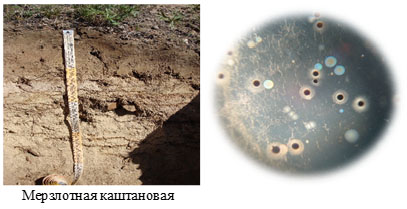Some biological properties of the Kuidusun depression soils of Oymyakon
DOI:
https://doi.org/10.31251/pos.v7i1.245Keywords:
Oymyakon; catenal soil series; labile organic carbon; CFU; enzymatic activity; CLPP.Abstract
The aim of the study. To investigate some microbiological properties of the catenal series of soils in the Kuidusun depression of the Oymyakon Highlands.
Location and time of the study. The study area is located in the vicinity of the Tomtor village (N63°15'41.94''; E143°10'26.91'') of the Oymyakonsky district of the Republic of Sakha (Yakutia, Russia). Soil samples were collected in the fall of 2011 at the main positions of the catena. The length of the catena is 38 km, the altitude a.s.l. is 727-821m. Soils are classified as Cambic Cryosols (fragic, мurshic), (forest); Skeletic Cryosols (aridic), (steppe meadow), Cambic Cryosols (fluvic), (typical meadow); Folic Cryosols (swampy meadow).
Methods. The content of labile soil organic matter (LOC) was determined photocalorimetrically in soil extracts with phosphate buffer (1/15 M, pH 6.8). The number of colony-forming units (CFU) was determined using standard MPA, KAA, and Czapek media. The functional spectrum of the soil microbiota was assessed using the community level physiological profile (CLPP) method. All properties were studied in 10 cm thick layers to a depth of 40 cm. Soil urease activity was assessed by ammonium production from urea.
Results. At the time of sampling moisture content of soil samples down the catena increased from 5 to 20%, whereas the LOC content increased from 2 to 6 g C /kg. In the 0–10 cm layer, the greatest accumulation of LOC was observed in the soil under a typical meadow. The highest number of CFU (150 million/g soil) in a dilute MPA medium was also found there. An increase in the proportion of CFU in the dormant state was revealed in the soil series from the lower position of the catena to the upper one. In the same series, an increase in the oligotrophic index of the community was noted. The highest metabolic activity was observed in the soil under a swampy meadow, whereas the lowest was shown by the soil under a forest. The enrichment of soil organic matter with microbiota cells increased in the series of soils f in the following order: a swampy meadow – a typical meadow – a steppe meadow, whereas the specific activity of the microbiota decreased. Urease activity of the soil was detected mainly in the 0–10 cm layer; in the underlying layers the activity was more than 500 times lower.
Conclusions. The biological properties of the studied soils corresponded to the known patterns established for the catenal series of soils in other soil and climatic conditions. The peculiarity of the studied soils was related to the extremely sharp differentiation of the microbiological profile. The absolute predominance of actinomycetes CFU in the soil under the steppe meadow was the major characteristic feature of the culturable part of the soil microbial community.
Downloads

Downloads
Published
How to Cite
Issue
Section
License
Copyright (c) 2024 The Journal of Soils and Environment

This work is licensed under a Creative Commons Attribution 4.0 International License.






